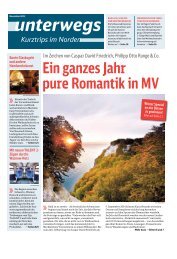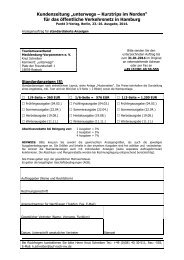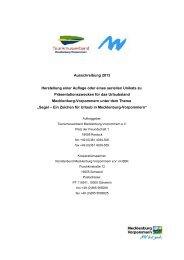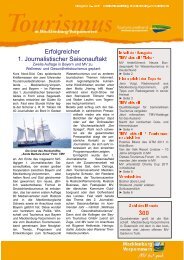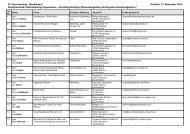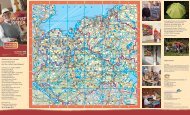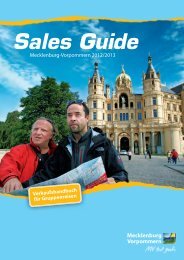Tagungsort Grand Hotel Heiligendamm
Tagungsort Grand Hotel Heiligendamm
Tagungsort Grand Hotel Heiligendamm
Sie wollen auch ein ePaper? Erhöhen Sie die Reichweite Ihrer Titel.
YUMPU macht aus Druck-PDFs automatisch weboptimierte ePaper, die Google liebt.
Die Bäderarchitektur im<br />
Marketing von Destinationen<br />
und Orten aus Großbritannien,<br />
Polen, Litauen,<br />
Russland und Deutschland<br />
Allan Brodie,<br />
English Heritage, The Engine House,<br />
Gorßbritannien<br />
Art and Culture in the Promotion of Seaside<br />
Resorts<br />
Today I will be discussing how some seaside<br />
resorts in England are using art and culture as<br />
key tools for regeneration, creating new attractions,<br />
improving existing facilities and attracting<br />
new visitors. Importantly, new residents<br />
are also being attracted by the quality of life at<br />
the seaside and a growing creative community<br />
and atmosphere is being created. To illustrate<br />
this I will concentrate on Margate in Kent, one<br />
<br />
been in serious decline since 1970s.<br />
Blackpool Beach<br />
In the third quarter of the 20th century the<br />
British seaside was booming. Millions of people<br />
came by car, train and bus for their annual<br />
holidays and crowded on to beaches, at least<br />
on sunny days, but the English seaside also<br />
provided its visitors with large facilities for indoor<br />
entertainment. Blackpool, Britain’s most<br />
popular resort, had the Winter Gardens, which<br />
had evolved in the 60 years since its opening<br />
in 1878 into a multi-functional entertainment<br />
complex on an industrial scale, its Opera<br />
House, Ballroom and Pavilion theatre each<br />
holding thousands of people at a time. And<br />
Blackpool also had its Tower, with the building<br />
beneath it housing a huge ballroom, a circus<br />
and other facilities, also capable of entertaining<br />
thousands at a time.<br />
And people wanted to live at seaside resorts<br />
Margate Arlington House 1960<br />
In the early 1960s at Margate a substantial<br />
seafront development took place including an<br />
attractive arcade with a tall skyscraper alongside.<br />
This scheme offered a bright future for<br />
new residents and visitors wanting to use the<br />
seafront arcade of shops.<br />
The 1950s seems like a golden age for the<br />
seaside holiday but the peak actually occurred<br />
in the mid-1970s when 40 million people took<br />
a holiday in Britain of four days or longer at<br />
the seaside.<br />
Margate Arlington House 2006<br />
However, other statistics show that the annual<br />
migration to the Mediterranean sun was<br />
already well underway. English seaside towns<br />
were now faced with competition from re-<br />
<br />
the familiar and the exotic. Mediterranean resorts<br />
were relatively new with a better climate<br />
and more modern facilities, whereas British<br />
seaside resorts had ‘the constraints of decaying<br />
infrastructure, designed for one era and<br />
not evolving, or not physically able to evolve,<br />
to accommodate the demands of another.‘<br />
Competition from the foreign holiday was not<br />
the only factor in the decline in the seaside’s<br />
popularity; people in the late 20th century<br />
could also choose from a wider range of domestic<br />
holidays and leisure activities.<br />
Margate Arlington Tower 2006<br />
A potentially vicious circle can exist where<br />
decreasing popularity leads to less private and<br />
public income to invest, which in turn leads to<br />
poorer facilities and therefore fewer visitors.<br />
Add to this media stories of dirty beaches, po-<br />
127



